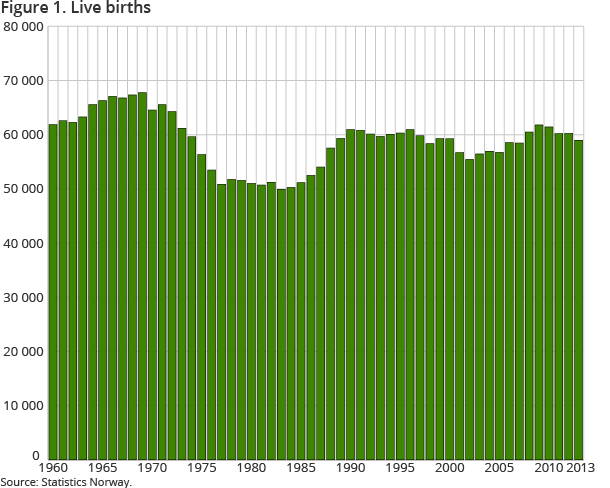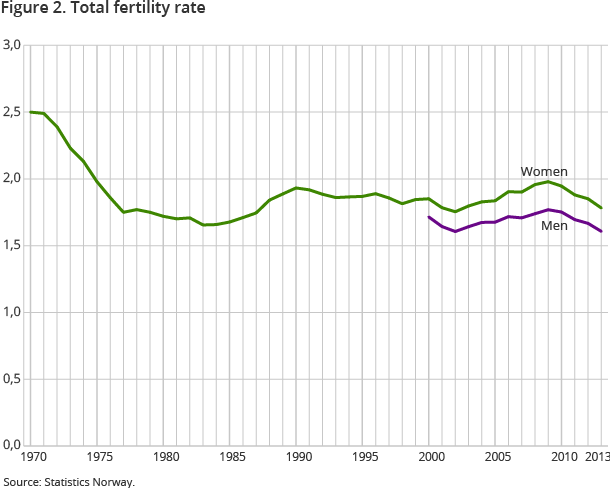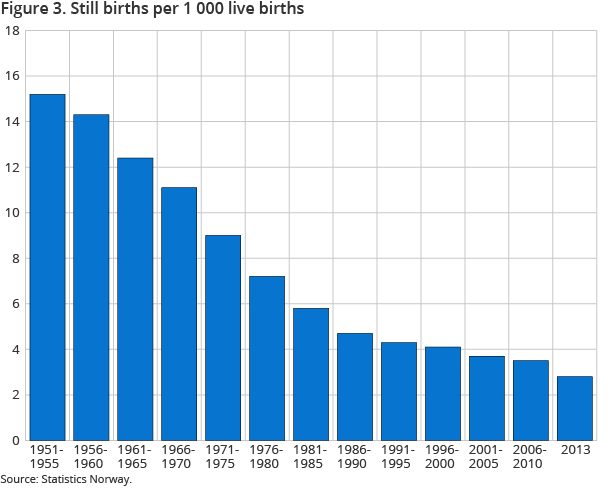Content
Published:
This is an archived release.
Further fall in fertility
A total of 59 000 children were born in Norway in 2013. This is 1 300 fewer than in 2012 and gives a total fertility rate of 1.78. This is the lowest fertility rate since 2002.
| 2013 | Change in per cent | ||
|---|---|---|---|
| 2012 - 2013 | 2003 - 2013 | ||
| Live births | |||
| Total | 58 995 | -2.1 | 4.5 |
| Boys | 30 138 | -2.6 | 3.9 |
| Girls | 28 857 | -1.6 | 5.1 |
| Total fertility rate | |||
| Women | 1.78 | -3.8 | -1.1 |
| Men | 1.61 | -4.2 | -1.8 |
| Age at first birth | |||
| Mother | 28.6 | 0.4 | 2.1 |
| Father | 31.3 | 0.3 | 2.0 |
| Cohabitation status of mother | |||
| Married | 25 553 | -2.6 | -8.6 |
| Cohabitation | 25 830 | -0.7 | 18.6 |
| Single | 7 612 | -5.0 | 13.1 |



After a peak with 61 800 live births in 2009 and a total fertility of 1.98, the number of live births has decreased somewhat in recent years. In the period 1981-1985, there was an average of 50 700 live births, and in the period 2006-2010 the figure was 60 200.
Highest fertility in the county of Nord-Trøndelag
The total fertility rate decreased in all counties from 2012 to 2013 except Nord-Trøndelag and Finnmark. The county of Nord-Trøndelag had an increase of 0.08 and the county of Finnmark had the second largest increase of 0.07. In addition, the county of Nord-Trøndelag had the highest fertility rate in 2013 with 2.03. The county of Vest-Agder had the second highest with 1.96. The county of Oslo had the lowest fertility rate in 2013 with 1.67, while the county of Hedmark had the highest decrease.
The total fertility for men was 1.61 in 2013, which is a decrease of 0.06 from the year before. The fertility rate for men was highest in 2009 with 1.77 during the period 2000-2013. Since 2009, the fertility rate has decreased every year.
Women aged 30-34 years had highest fertility
The fertility decreased in all age groups from 2012 to 2013, apart for women aged 40-44 years. The fertility in this age group has increased somewhat, but steadily, almost every year since the middle of the 1980s. Women aged 30-34 years had the highest fertility rate in 2013, as it has been for the last four years. Women aged 25-29 years had the second highest fertility rate in 2013.
A small increase in age at birth
The mean age at first child’s birth was 28.6 years for women and 31.3 years for men in 2013. The mean age at first child’s birth in the period 2003-2010 was around 28 years, and since then it has increased somewhat every year.
In 2013, 954 sets of twins were born and 17 sets of triplets, corresponding to 16.7 multiple births per 1 000 births.
In 2013, there were 166 still births. This is the lowest figure of still births ever registered. This corresponds to 2.8 still births per 1 000 births. This is the first time this figure has been below 3.
Contact
-
Statistics Norway's Information Centre
E-mail: informasjon@ssb.no
tel.: (+47) 21 09 46 42
-
Espen Andersen
E-mail: espen.andersen@ssb.no
tel.: (+47) 92 61 00 46
-
Ane Margrete Tømmerås
E-mail: ane.tommeras@ssb.no
tel.: (+47) 91 99 29 62
-
Oppdrag befolkningsstatistikk
E-mail: befolkning@ssb.no
